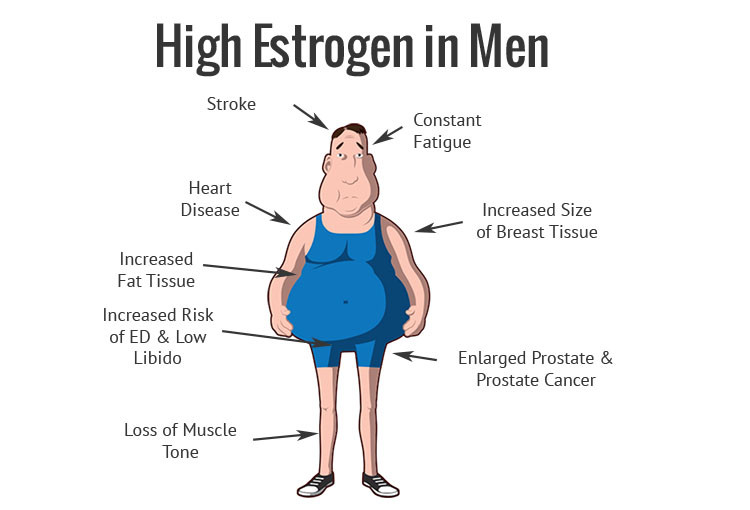In this article we will look at how male hormones and biochemistry work, how problems are started in the prostate gland, and what might be done to treat them.
What are Hormones?
Hormones bring important messages to every cell of your body. They travel in your bloodstream where they bind to carrier proteins and are slowly released into tissues throughout the body. They work slowly, over time, and affect many different processes, including:
- Growth and development
- Metabolism – how your body gets energy from the foods you eat
- Sexual function
- Reproduction
- Mood
Endocrine glands, which are special groups of cells, make hormones. The major endocrine glands are the pituitary, pineal, thymus, thyroid, adrenal glands, and pancreas. In addition, men produce hormones in their testes and women produce them in their ovaries.
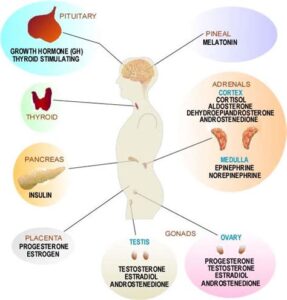
Hormones are powerful. It takes only a tiny amount to cause big changes in cells or even your whole body. Evidence shows that hormonal imbalances are the root cause of many chronic health issues (prostate cancer, strokes, heart attacks etc.). Laboratory tests can measure the hormone levels in your blood, urine, or saliva. The only way to know if hormones are in balance in the body is to test them. This article will focus on saliva hormone testing.
3 Questions That Need Answers for Hormone Balance
- Are my symptoms caused by a hormone imbalance?
- Which hormones do I need to regain hormone balance?
- How do I use hormones for optimal health and balance?
Testosterone/Estradiol/Progesterone are the 3 hormones most often out of balance in men. Testosterone is our most important anabolic hormone, meaning it helps cells create energy from the food we eat, builds muscle and bone, contributes to sex drive and is needed by the brain for proper brain function. Testosterone is responsible for male hair growth, muscle development and deep voice. From about age 40, testosterone declines approximately 1% per year. Estradiol is the hormone that creates female characteristics such as breasts. Men make estradiol, but in their young and middle adult life they make more testosterone, sufficient to block female breast development. The testosterone to estradiol ratio important to men. Progesterone balances the effects of estrogen and most other hormones are made from it. The progesterone to estradiol ratio is also important for male hormone balance.
DHEA (dehydroepiandrosterone) is a precursor to testosterone, estrogen and progesterone meaning that these hormones are made from it. DHEA is made primarily in the adrenal glands and is essential for protein building and repair. DHEA levels decline dramatically as we age, making it a primary biomarker of aging.
What is the Prostate Gland?
It is a small gland that is part of the male reproductive system. It’s supposed to be about the shape and size of a walnut. It rests below your bladder and in front of your rectum. The posterior side of the prostate can be easily palpated by placing a finger in the rectum (this is usually performed by a urologist). The prostate surrounds part of the urethra, the tube in your penis that carries urine from your bladder. The prostate helps make some of the fluid in semen, which carries sperm from your testicles when you ejaculate. There is a sphincter (valve) at the top and base of the prostate. These sphincters control urine flow. When urinating, both sphincters open. When ejaculating, the top sphincter is closed and the bottom one opens.

The actions of the prostate gland are controlled by the hormones, testosterone, estradiol and progesterone, which are made mostly by the testes.
Benign Prostatic Hypertrophy (BPH)
BPH (enlarge prostate) is a health issue that becomes more common with age.
Common symptoms of BPH include:
- Frequent or urgent need to urinate
- Urinating more often at night (nocturia)
- Trouble starting to urinate
- Weak urine stream, or a stream that stops and starts
- Dribbling at the end of urination
- Not being able to fully empty the bladder
Risk factors for an enlarged prostate include:
- Aging. An enlarged prostate gland rarely causes symptoms before age 40. After that, the chance of having an enlarged prostate and related symptoms starts to rise.
- Family history. Having a blood relative with prostate problems makes you more likely to have problems with your prostate.
- Diabetes and heart disease. Studies show that diabetes might raise the risk of BPH. So might heart disease.
- Lifestyle. Obesity raises the risk of BPH. Exercise can help lower the risk.
If you are experiencing some or all of these symptoms, it is prudent that you consult with a urologist. Typically, a urologist will perform a digital rectal exam to evaluate the prostate. In some men, the obstruction of urine flow is from enlargement of the prostate. In others, however, the obstruction is due to smooth muscle contraction of the urinary sphincters in the prostate gland, causing the same urinary symptoms, without the prostate enlargement. In some men. the problem is mixed. Since either or both of these problems (prostate cell overgrowth or urethral constriction) lead to similar urination problems, it is sometimes difficult to diagnose the issue.
BPH & 5-alpha-reductase
In the prostate is an enzyme (5-alpha-reductase) that converts testosterone into dihyrdotestosterone (DHT). DHT stimulates to proliferation of prostate cells, more than testosterone, enlarging the prostate gland and narrowing the urethral channel, leading to urinary problems. Inhibiting the conversion of testosterone to DHT is often a treatment goal for men with BPH.
Note: Check out this link to steroidogenesis if you are a total nerd like me and need to understand all of these biochemical processes!
Drugs that inhibit 5-alpha-reductase:
- Proscar (finisteride)
- Avodart (dutasteride)
- Jalyn (dutasteride / tamsulosin)
Other products that could inhibit 5-alpha-reductase:
- Saw Palmetto Berry Extract
- Progesterone
BPH & alpha-1-selective adrenoreceptor blocking agents
In BPH caused by obstruction of the urinary sphincters due to smooth muscle contraction, conventional medicine often uses alpha-1-selective adrenoreceptor blocking agents. The alpha-1-selective adrenoreceptor blocking agents bind to and block alpha-1 receptors. They are mostly used to treat high blood pressure or symptomatic BPH because alpha-1 receptors are located in the smooth muscle lining blood vessels, in the prostate, and in the neck of the bladder.
These conditions are characterized by a tightening (contraction) of smooth muscle because the alpha-1 receptors are stimulated. If this occurs in smooth muscle located in the prostate and neck of the bladder, this tightening can detrimentally affect urine flow and frequency, causing symptoms such as those seen in BPH. Alpha-1-selective adrenoreceptor blocking agents block these receptors, allowing this muscle to relax and resolving symptoms.
Drugs that block alpha-1 receptors:
- Flomax (tamsulosin)
- Rapaflo (silodosin)
- Uroxatral (alfuzosin)
- Hytrin (terazosin)
What About Hormone Balance for Men?
As men age their estrogen increases and testosterone and progesterone decreases. Thus with aging in men, estrogen dominance can occur. This estrogen dominance is more pronounced in obese men.
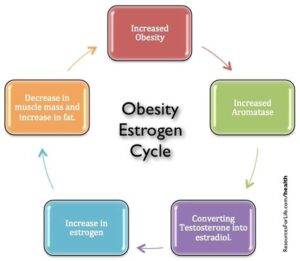
Note on xenoestrogens: we are exposed daily to these through plastics and pesticides; off-gassing from particle board and carpets and consumption of synthetic hormones in meat and dairy products. As a result, we carry an unnatural burden of foreign estrogens (progesterone supplementation may help protect us from their effects).

Saliva Hormone Testing
Saliva testing is a non-invasive collection method where patients collect their saliva in plastic tubes in order to measure hormones like cortisol, estradiol, progesterone, and testosterone. This non-invasive saliva collection is ideal for patients because it allows them to collect their sample in the privacy of their home or office.
Why Do We Test Hormones in Saliva?
 The reason we test hormones in saliva, is because they are representative of the bioavailability or free concentration of a particular hormone. Steroid hormones (testosterone, estradiol and progesterone) are created from cholesterol that freely diffuse out of the bloodstream into the salivary glands and move into the saliva. When a hormone is produced by the different glands of the body (testes, ovaries, adrenals etc.) they are released into the bloodstream and most (95-99%) are bound to carrier proteins. Estradiol and testosterone become bound to sex hormone binding globulin (SHBG), so only 2% of the hormone is bioavailable (free) to move into tissue. Therefore, measuring hormones in saliva is measuring the bioavailable fragment of hormones (the amount that is available to target tissues) and better relates to specific symptoms of excess or deficiency. ZRT measures hormones from a single morning sample, which represents the peak of daily hormone production – the optimal time to measure.
The reason we test hormones in saliva, is because they are representative of the bioavailability or free concentration of a particular hormone. Steroid hormones (testosterone, estradiol and progesterone) are created from cholesterol that freely diffuse out of the bloodstream into the salivary glands and move into the saliva. When a hormone is produced by the different glands of the body (testes, ovaries, adrenals etc.) they are released into the bloodstream and most (95-99%) are bound to carrier proteins. Estradiol and testosterone become bound to sex hormone binding globulin (SHBG), so only 2% of the hormone is bioavailable (free) to move into tissue. Therefore, measuring hormones in saliva is measuring the bioavailable fragment of hormones (the amount that is available to target tissues) and better relates to specific symptoms of excess or deficiency. ZRT measures hormones from a single morning sample, which represents the peak of daily hormone production – the optimal time to measure.
Symptoms of Possible Hormone Imbalance
To find out how your symptoms correlate to a possible hormone deficiency take the Hormone Balance Test (make sure to take the test for men). If you have 2 or more of the symptoms in a category, then there’s a good chance that you have that hormone imbalance (you can have more than 1 type of hormonal imbalance). Candidates for hormone testing include men who are struggling with:
Testosterone deficiency: (most common in men over the age of 50)
- weight loss
- enlarged breasts
- loss of muscle
- low stamina
- low sex drive
- softer erections
- fatigue
- gallbladder problems
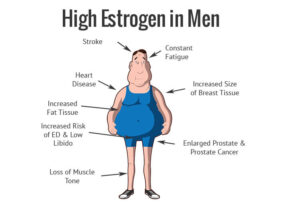
Excess estradiol: (excess estradiol can be balanced with one of the male hormones and changes in diet and lifestyle)
- hair loss
- headaches
- prostate enlargement
- enlarged breasts
- irritability
- weight gain
- puffiness/bloating
Other Factors in Hormone Imbalance
Poor diet, including excess sugar and carbohydrates; lack of healthy fats (such as omega-3 fatty acids); lack of fiber and nutrients found in natural whole foods, and alcohol consumption.
Toxin exposure, such as with pesticides.
Stress depletes the adrenal glands and create imbalances among all hormones.
Lifestyle issues such as lack of exercise, lack of sleep and cigarette smoking.
Combining hormone balancing with correction of environmental and lifestyle factors offers the best opportunity for reducing symptoms of hormone imbalance.
Balancing Male Hormones (Saliva Test)
The following is an example of a ZRT Saliva Test Report:
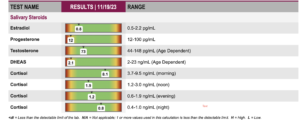
Testosterone deficiency is a saliva testosterone level below 44 pg/mL (for a 50-year old).
Excess estradiol is a saliva estradiol level above 2.2 pg/mL (for a 50-year old).
To restore hormone balance you want your hormone ratio of testosterone/estradiol and progesterone/estradiol to be 200-300/1. In the test above, the testosterone/estradiol ratio is 73/.8 = 91 and the progesterone/estradiol ratio is 12/.8 = 15.
The temporary use of transdermal progesterone at 5-8mg/day and/or transdermal testosterone (need a medical prescription) at 1-2mg/day could help restore healthy ratios of hormones.
In the test case above, it was decided to supplement with 8mg of transdermal progesterone cream based on the progesterone/estradiol ratio of 15 and the client’s symptoms.
It is important to retest the saliva hormones after 3 months of treatment to verify that you are creating the desirable outcome in your hormone levels.
Nutritional Supplements That Can Help
Zinc – 20-30 mg/day
Selenium – 60-120 mcg/day
Vitamin D – 400 mg/day
Vitamins A/C/E in RDA recommended doses.
If you are interested in doing a saliva hormone test, pick up a testing kit at Back to Function and let us help you FEEL – RECOVER – PERFORM BETTER!
References:
What is the Prostate?. webmd.com.
Benign Prostatic Hyperplasia (BPH). mayoclnic.org.
John R. Lee. Hormone Balance for Men.


